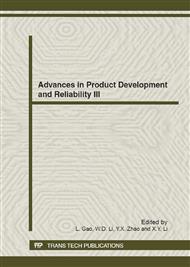[1]
Wong FS. Slope reliability and response surface method. J Geotech Eng1985;111(112):32–53.
Google Scholar
[2]
Faravelli L. Response surface approach for reliability analysis.J Eng Mech1989;115(12):2763– 81.
Google Scholar
[3]
Youn, BD ,Choi, KK .A new response surface methodology for reliability-based design optimization.Computers & Structures.Volume 82, Issues 2–3, January 2004, Pages 241–256
DOI: 10.1016/j.compstruc.2003.09.002
Google Scholar
[4]
Xiao-hui Tan , Wei-hua Bi, Xiao-liang Hou, Wei Wang.Reliability analysis using radial basis function networks and support vector machines.Comput Geotech, 38 (2) (2011), p.178–186
DOI: 10.1016/j.compgeo.2010.11.002
Google Scholar
[5]
Haldar A, Mahadevan S. Probability, reliability, and statistical methods in engineering design. New York: Wiley and Sons; 2000.
Google Scholar
[6]
Youn BD, Choi KK, Du L. Adaptive probability analysis using an enhanced hybrid mean value method. Structural and Multidisciplinary Optimization 2005;29(2):134–48.
DOI: 10.1007/s00158-004-0452-6
Google Scholar
[7]
Li HS, Lv ZZ, Yue ZF. Support vector machine for structural reliability analysis.Appl Math Mech 2006;27(10):1135–43.
Google Scholar
[8]
S. Missoum, P. Ramu, R.T. Haftka, A convex hull approach for the reliability-based design of nonlinear transient dynamic problems, Comput. Meth. Appl.Mech. Engrg. 196 (2007) 2895–2906.
DOI: 10.1016/j.cma.2006.12.008
Google Scholar
[9]
A. Basudhar, S. Missoum, A.H. Sanchez, Limit state function identification using support vector machines for discontinuous responses and disjoint failure domains, Prob. Engrg. Mech. 23 (1) (2008) 1–11.
DOI: 10.1016/j.probengmech.2007.08.004
Google Scholar
[10]
A. Basudhar, S. Missoum, Adaptive explicit decision functions for probabilistic design and optimization using support vector machines, Comput. Struct. 86 (19–20) (2008) 1904–1917.
DOI: 10.1016/j.compstruc.2008.02.008
Google Scholar
[11]
Greg Schohn, David Cohn. Less is More: Active learning with support vector machines. In: Proceedings of the 17th international conference on machine learning. San Francisco, CA, USA: Morgan Kaufmann Publishers Inc.; 2000. p.839–46.
Google Scholar
[12]
Shawe-Taylor J, Cristianini N. Kernel methods for pattern analysis. Cambridge University Press; 2004.
Google Scholar
[13]
Tou JT, Gonzalez RC. Pattern recognition principles. Addison-Wesley; 1974.
Google Scholar
[14]
C.-W. Hsu, C.-C. Chang, C.-J. Lin. A practical guide to support vector classification.
Google Scholar
[15]
C.-C. Chang and C.-J. Lin. LIBSVM : a library for support vector machines. ACM Transactions on Intelligent Systems and Technology, 2:27:1--27:27, 2011.
DOI: 10.1145/1961189.1961199
Google Scholar
[16]
Gunn SR. Support vector machines for classification and regression. Technical Report ISIS-1-98, Department of Electronics and Computer Science, University of Southampton; 1998.
Google Scholar
[17]
Butler AN. Optimal and orthogonal latin hypercube designs for computer experiments. Biometrika 2001;88(3):847–57.
DOI: 10.1093/biomet/88.3.847
Google Scholar
[18]
Romero VJ,Burkardt JV,Gunzburger MD,Peterson JS. Comparison of pure and Latinized centroidal Voronoi tesselation against various other statistical sampling method.J Reliab Eng Safety 2006;91:1266-80.
DOI: 10.1016/j.ress.2005.11.023
Google Scholar


